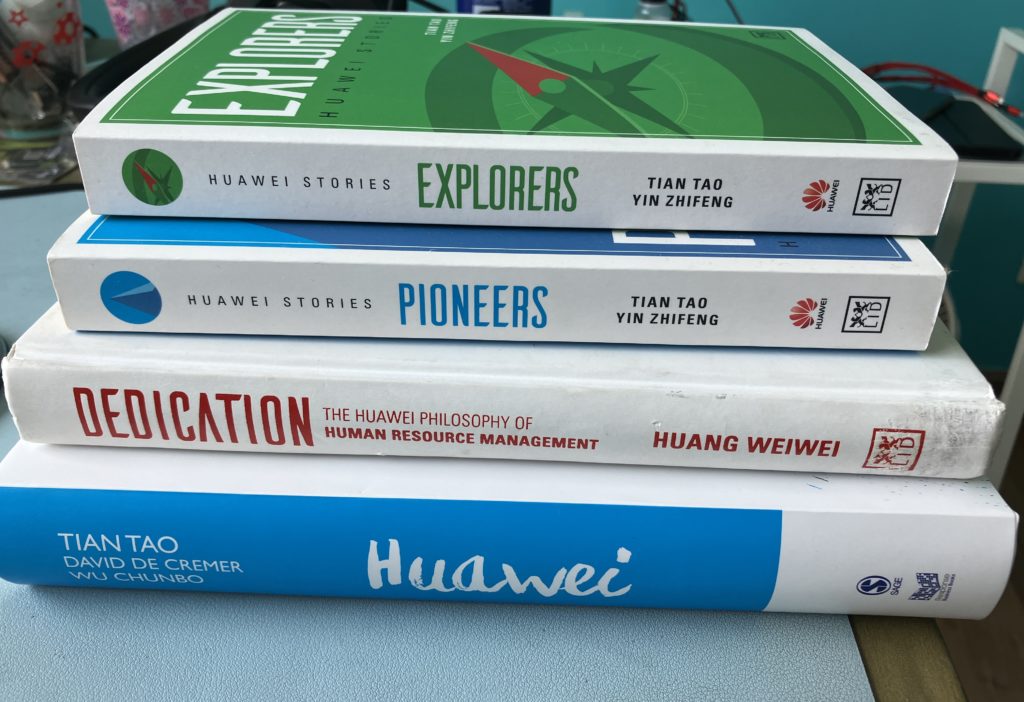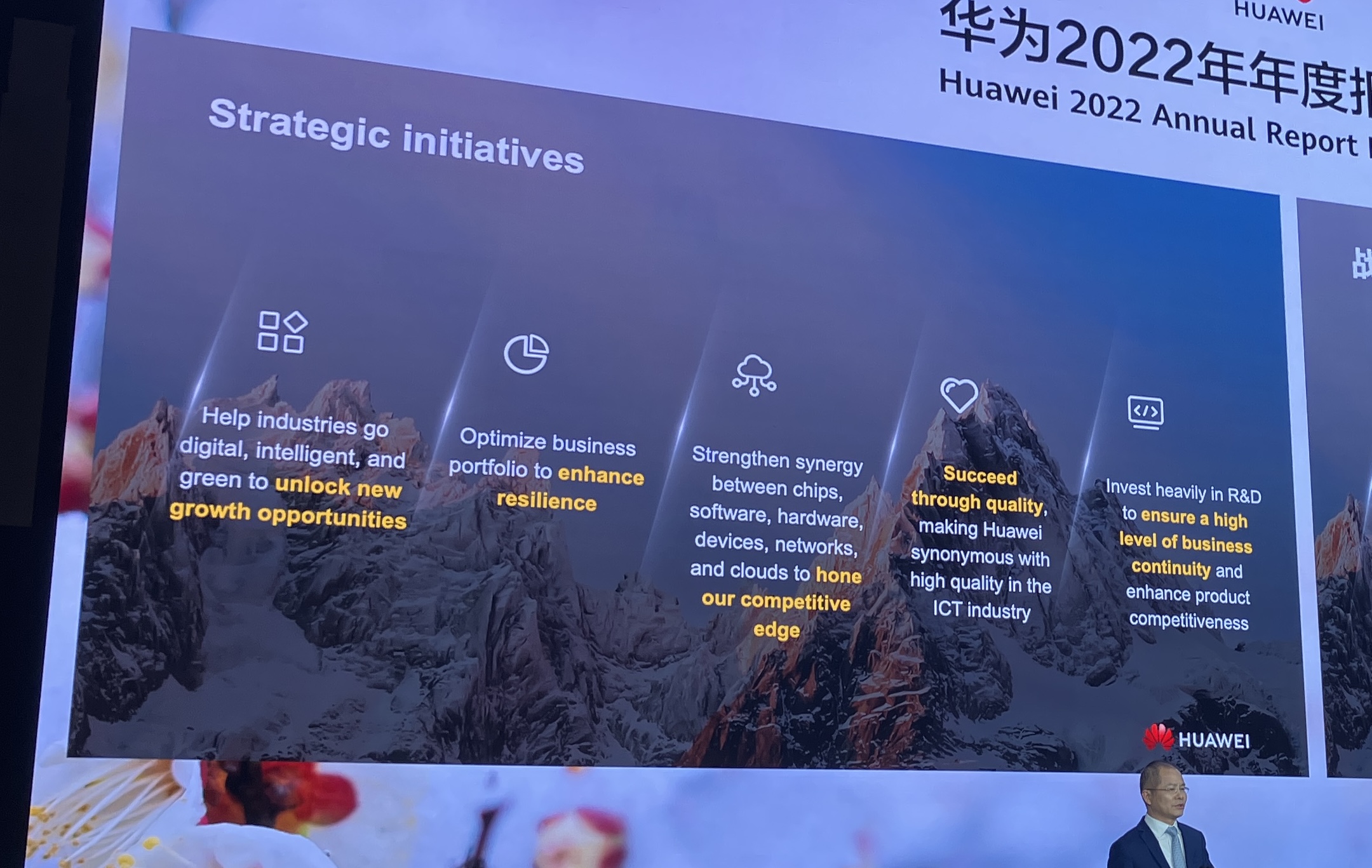At the recent 2022 Huawei annual report meeting in Shenzhen, I sat down with Chairman of the Supervisory Board Guo Ping. I had spoken to him a few years ago when he was still one of the rotating Chairmen (see the above picture). But he has since become President of their Board of Supervisors, which is an interesting body tasked with overseeing parts of the management and operations.
During our talk, he had an interesting comment about how his career has gone from “managing people” to now “managing the rules and systems”. That was a really important idea and is the point of this article. Plus, I’ll recap the conversation a bit.
First, a Quick Summary of HR at Huawei
I have written a lot about the culture and HR systems at Huawei. I think these are their most important strengths. You can see some past writing on this here:
- Huawei Is Going to Beat Trump with Human Resources, Not Technology (Pt 1 of 3)
- Huawei’s Employee Stock Ownership Plan (ESOP) is “Meritocracy Plus Partnership” at Scale in China Tech. (Pt 2 of 3)
In these articles, I wrote:
“Huawei, like most engineering-based enterprises, has only one real resource, which is the cumulative brainpower of its people. This is the resource that creates the products and sells them to their customers. And as technology changes quickly, they must continually create and recreate the products – and therefore the value of the enterprise. Huawei’s main strength is the system they have developed for the creation, assessment, and distribution of value by +190,000 people. It’s about HR strategy.”
I still think that is pretty much on point. Telecommunications equipment goes obsolete pretty fast. So, it’s all about creating new technologies and products.
Here’s a comment by founder Ren Zhengfei.
“Resources can be exhausted; only culture endures. Huawei does not have any natural resources to depend upon. What we do have is the brainpower of our employees. This is our oil, our forest, and our coal. Human ingenuity is the creator of all wealth.” – Ren Zhengfei
Mr. Ren is pretty much retired. But he has been writing about culture and how to survive as a company for thirty years. He’s actually pretty direct and funny. He has an engineer’s brain.
Arguably, the biggest part of Huawei’s people strategy is its ESOP program. Certain employees can buy shares in the company and benefit from longer-term increases in value of the company. This is how they tie compensation to performance long-term. I wrote:
“Huawei is very focused on how its employees create and continually re-create the value of the enterprise…Huawei is regarded mostly as a technology company; I think of it much more as a human resources company. They have an HR strategy that is very effective at creating incentives for their +190,000 employees. And the ESOP is a structural pillar of this HR strategy.”
But what Guo Ping is now focusing on in his new role is the training and creation of leaders within the company. The ESOP system depends on identifying certain individuals in the company. And really the entire HR system depends on measuring performance and potential of employees. Then it provides identified individuals not only with the option to buy shares – but also systematic training and exciting career paths.
What Mr. Guo and I talked about was how to do such rankings and assessments not by people but by a system. And to do it effectively at a very scale large. And to do it in a way that is immune to personal preferences and politics. That is what he meant by going from managing people to managing the rules and system.
On Meritocracy Plus Partnership at Scale
American capitalists (like me) say that shareholders are the stakeholders with ultimate say in a company. They are the owners.
If you ask European companies about how to distribute a firm’s economic value, you will hear more talk about multiple stakeholders, such as employees, owners and the community. And you might even hear some talk about “stakeholder capitalism” and the triple income statement (both really bad ideas).
But at Huawei, the only stakeholders you ever really hear about are the current employees. It’s all about the current, top contributing employees. Other shareholders, providers of capital, retired employees and even the founders are all a distant second in terms importance.
What the company tries to do is to directly tie the creation of economic value to its distribution. They want most of the wealth created to go to the current, top contributing employees who created it. The system they use if “meritocracy and partnership”. That’s my term.
- They do systematic rankings and advancement based on performance. And you rise and fall based on your performance. That’s meritocracy.
- They then make those people partners, and the beneficiaries of most of the economic value. You also get the losses if the firm underperforms. That’s partnership.
Huawei to me looks a lot like what 3G capital has been doing at consumer-facing companies like Budweiser and Burger King. But they have instituted “meritocracy and partnership” on a much larger scale. And at a business that is highly technical. You don’t have tens of thousands of engineers creating new technologies at Burger King. Huawei now has 207,000 employees in total, among which 55.4% of them work in R&D.
A useful ratio to remember for Huawei is 4-to-1. After you take out the basic costs of goods sold, depreciation and such, you get a gross margin for the company that then goes to the providers of labor and capital. And at Huawei, this money goes about 4-to-1 to current employees vs. everyone else. The company focuses its operational cash flow on current employees, with a heavy weighting to the top performers. The rest of the 4-to-1 goes to owners and other stakeholders (including retired employees).
Huawei is Awesome at Inspiring Dedication in their Current, Top Contributing Employees
As mentioned, the over-riding principle at Huawei appears to be that the top contributing, current employees should get the vast majority of the economic value created. And that is pretty logical. If brainpower is Huawei’s main resource, this is the group that creates that value. So, recruiting and motivating this group is the biggest priority. And they don’t just want them motivated. They want them completely dedicated to the enterprise. They want them “all in”.
As I’m writing this, there are four Huawei books on my desk. These are books they give to employees and others about their company. Note the titles.

The book Dedication: The Huawei Philosophy of Human Resource Management is really the best book about how they operate. Note the word dedication. That’s what they want. They want their key employees (tens of thousands) to spend their entire careers at the company. Something very rare in China where people jump jobs every year.
In practice, this is actually pretty complicated. It’s a really big company. Staff are at many different stages of their lives and careers. How do you get current staff, senior staff, and incoming staff to go “all in” in creating value for customers – and therefore the enterprise?
You don’t just give them money. You have to give them exciting careers. You have to give them training and personal development. And you have to give them the opportunity to rise to the top. That means you have to tell the current senior people to leave and make space, including the founders.
My outsiders’ take is that Huawei is mostly focused on motivating teams and team managers. High performance teams with aggressive and dedicated managers are the true engine of Huawei. And these teams are mostly in sales and marketing and R&D. Those are the teams that make the largest contributions to the customers and therefore the enterprise. That’s pretty logical I think. You motivate at the team level and within the departments that matter most. And then you scale it up.
But how do you assess contributed value?
Staff are rated every 6-12 months across metrics such as sales performance (usually team-based), talent, dedication, and the potential for advancement. The phrases I keep coming across are “dedicated employees” and “high-performance teams”. According to Ren, “we value dedication, contributions and potential.”
Ok, once assessed, how do you reward performance?
High-performing contributors are given higher bonuses of course. But they are also identified and given more opportunities (and responsibilities). They are given more training. And they are given the option to participate in the employee share ownership program (very important). Low performers, in contrasted, are demoted, or exited. Meritocracy works in both directions.
My Discussion with Guo Ping
Ok. With that background, let me get back to my conversation with Mr. Guo.
We sat by the lake at the corporate headquarters in Shenzhen. It’s really a pretty fantastic facility, mostly because founder Ren loves European architecture. So, buildings look like French Chateaus.

Sitting at a table by the lake (not the one above), we talked about how Huawei and his own life had changed in the past two years. My points below are my summary and impressions from the conversation. These are not quotes or stated positions by Mr. Guo.
The biggest change is that Huawei has undergone a major restructuring and rebuilding, a result of the entity list ban which impacted their businesses and supply chain. The primary focus appears to have been on rebuilding the supply chain and ensuring greater resilience in the businesses overall. You’ll hear this word “resilience” a lot from senior management now. They are mostly talking about external factors such as government actions.
Below is Mr. Xu’s summary of Huawei’s strategic priorities from the annual report. Note the word resilience.

Founder Ren Zhengfei recently said that +13,000 parts and +4,000 circuit boards have been redesigned or replaced to accomplish this. But Chairperson Eric Xu also recently said that Mr. Ren was probably referring to the last ten years, not the last year or so. It’s not clear. But the key point is that this process of redesigning circuit boards and restructuring the supply chain to be less dependent has largely been completed now. The goal is to make sure every component of the supply chain is not dependent on any single company or country.
In practice, Huawei has become a tremendous friend to suppliers in the past two years. Rebuilding the supply chain means working with suppliers to redesign and / or source replacement parts. That means lots of investment and coordination. It’s probably been a pretty good couple of years to be a Huawei supplier. And it looks like a lot of Huawei’s big R&D spend has been in this area. The biggest challenges remain in handset chipsets and in the participation of developers and companies in their HarmonyOS operating system. But really they need multiple sources across the entire supply chain. Note the word continuity in this slide.

We also talked about his move from chairman to president of the supervisory board. And he was definitely much more relaxed that two years ago. He was sporting business casual attire instead of his typical suits. And he said he spends much less time traveling and more time reading.
But the big topic was human resources and his role as President of supervisory board. And he mentioned that his +30-year Huawei career had three phases.
- Phase 1 was about making stuff happen. Getting the job done.
- Phase 2 was about leading and managing people and hitting organizational objectives.
- Phase 3 (the current phase) was no longer about managing people. It was about managing the rules.
Huawei’s Board of Supervisors: Managing the Rules and Systems
Supervisory Boards are common in Germany and China. It’s part of a two-tier board system where there also a board of directors. Chinese companies have a board of directors (董事会) and a board of supervisors (监事会). We don’t see this so much in the US where there is usually a one-tier board of directors.
In theory, Boards of Supervisors are supposed oversee and appoint the members of the management board and approve major business decisions. Plus, they are supposed to do a monitoring role. But it changes quite a lot in practice.
What’s interesting about this for Huawei is the role the supervisory board is playing within both training and long-term leadership management and development. The 15 supervisors are charged with cultivating talent and the company’s core values. This includes training and promoting future talent and leaders. Mr. Guo referred to it as less about business operations oversight and more about people – specifically their selection, training, and career paths. So, it fits right into the human resources and culture aspects just discussed. He also noted that Huawei’s supervisors typically have more experience than the board members.
Mr. Guo described the training system as having three levels.
I mentioned there extensive measuring and ranking of individual performance and potential. This begins with first line managers. He said 30% of these are selected for the Internal Training Center. This is level one. These first line managers get trained in critical thinking, project management skills and systems engineering. They also get trained on installation and spend time in the field. They call this approach “1 + X + Field”. 1 is more about full time experience. “Field” is more about experience while working.
The next level is for mid-level managers. These can be country managers, branch office managers and other functional leaders. These managers typically oversee 100 people. It seems to be the same “1 + X + Field” approach. And the third level is obviously the highest level.
What is really happening is each employee is building an internal resume inside the company. Just like a CV, but all internal to Huawei. Their CV details their experiences, values, and skills. He did mention that the most important factors are experience and competence.
And by building an internal database with resumes, the system can (in theory) easily match needs with the right person. So, it’s almost like an internal recruiting marketplace.
Final Point: Huawei is Going from Fast Follower to Leading Innovator
One of the really interesting things that has happened at Huawei in the last 2 years is an accelerated transition from fast follower to a leader in technology. For much of its history, Huawei was a big manufacturer and a very aggressive operator (particularly in sales). But it mostly followed leaders like Ericsson in terms of technology.
However, over the past ten years, Huawei has increasingly become a technology leader. They largely copied 4G but were a key player in developing 5G. And this has big implications for human resources and human capital. You really need different people for creating entirely new technologies vs. aggressively selling manufactured products. And in 2020, we heard Chairman Liang Hua talk about how they were beginning to change their HR policies to attract more “geniuses” to the company.
The entity-list ban really accelerated this transition from fast follower to leading innovator.
Mr. Guo said they have two different tracks now. There is the management track, which is most of what I just described. This is about IPMT (Integrated Portfolio management Team) which creates teams with members with expertise in sales, manufacturing, service and whatever else is needed to sell and execute in countries.
But there is also the expert track, which is ITMT (Integrated Technology Management Team). This is less success and sales oriented. This is more about doing R&D. And it is more open and collaborative with universities and other external partners. This is their core research division. And a lot of money is flooding into this right now. I’ll talk about that in the article summarizing their 2022 financials.
***
That’s it for the interview. It was a pretty fun talk. I am generally bullish on Huawei. Mostly because of their culture and HR policies that really seem to work at scale.
Cheers, Jeff
———
- Alibaba, Android and The Emerging Art of Ecosystem Management. (Jeff’s Asia Tech Class – Podcast 57)
- 4 Things Everyone Is Getting Wrong About Huawei’s 2019 Annual Report
- Can Huawei’s HarmonyOS Break Android’s Monopoly? (Asia Tech Strategy – Podcast 73)
From the Concept Library, concepts for this article are:
- DOB5: Leadership and Management
- DOB6: Staff, Culture and Teams
From the Company Library, companies for this article are:
- Huawei
———–
I am a consultant and keynote speaker on how to increase digital growth and strengthen digital AI moats.
I am the founder of TechMoat Consulting, a consulting firm specialized in how to increase digital growth and strengthen digital AI moats. Get in touch here.
I write about digital growth and digital AI strategy. With 3 best selling books and +2.9M followers on LinkedIn. You can read my writing at the free email below.
Or read my Moats and Marathons book series, a framework for building and measuring competitive advantages in digital businesses.
This content (articles, podcasts, website info) is not investment, legal or tax advice. The information and opinions from me and any guests may be incorrect. The numbers and information may be wrong. The views expressed may no longer be relevant or accurate. This is not investment advice. Investing is risky. Do your own research.
